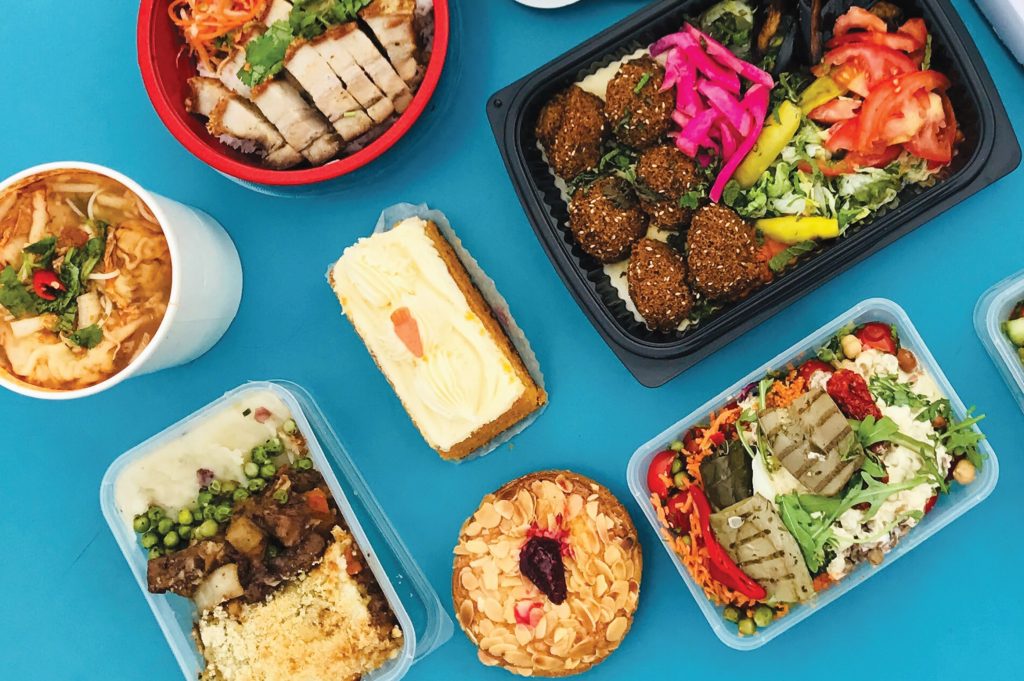A Look Ahead
Posted by estiator at 10 January, at 08 : 23 AM Print
What will be trending in the year ahead as restaurants consider a post-COVID world?
By Constantine Kolitsas

Let the trend be your friend— that’s what stock gurus say, and
while it’s generally true of trends within the restaurant industry, it’s a challenge to see which of those from 2020 are here to stay and which were temporary pivots in a surreal world mired in pandemic and unparalleled political hyperbole. Unlike years past, the trends for restaurants in 2021 have less to do with food and more to do with the adaptation of new business models and technology. To say that 2020 was not a “business-asusual” year is, of course, an understatement. And so, for our first issue of the new year, Estiator looks at what some of the industry analysts are saying, while comparing it to what we ourselves see and believe is on the horizon.
Would You Like That for Takeout or Delivery?
• • •
What They Say: For years, takeout and delivery have been universally identified as the fastest (and often only) growth segment within the restaurant industry. Of course, COVID tore the roof off this business segment, and while there may be a contraction associated with the numbers of people returning to eat inside restaurant dining rooms, the natural progression of growth has been accelerated to a significant degree.
What We Say: Takeout and delivery are here to stay as a significant business segment. If you’ve improved your systems in response to the dining room closures, be sure to keep those improvements in place as COVID hits our rearview mirror. Don’t treat takeout as the redheaded stepchild of your operation but embrace it as a separate business within your business, and apply the same focus and intensity with regard to zero errors, efficiency, and quality. Create menus that are travelfriendly and can be quickly executed. Time-to-consumer is naturally longer when it comes to delivery, so don’t burden your menu with items that take a long time for your short-order cooks to produce.
Click to Add to Your Cart
• • •
What They Say: Online ordering through various channels (mobile apps, websites, third-party ordering hubs/ delivery companies, social media platforms) will continue to grow, outpacing the growth it has experienced over the past five years.
What We Say: Estiator agrees that this will continue to grow, and for several reasons: Younger people (for whom technology has been a birthright) are entering into consumerhood; a new segment of germaphobes will emerge that will make a conscious effort to limit in-person interactions; and restaurants using the technology will see the inherent benefits (less headcount, fewer errors). If you haven’t explored it yet, it’s never too late. We recommend avoiding the big delivery services like Grubhub, DoorDash, etc., as they will cannibalize profits from the entire operation. Instead, look to companies that can develop a mobile app for you and tie it to your website’s online ordering platform. Promote it constantly on Facebook, Instagram, and other platforms to give you the visibility you are missing by opting out of the aforementioned companies.
Do You Have Outdoor Heaters?
• • •
What They Say: The expansion of outdoor dining during the pandemic will be permanent while the elimination of many seats within restaurants will also be something that restaurants will need to accept.
What We Say: Outdoor dining has always been popular, but guests will come to expect a nicer outdoor experience than most have previously provided, necessitating investment on the part of restaurants to make these spaces more appealing. While it would be great to think that the waiver on the part of municipalities with regard to permits and fees would be permanent, we expect that once the worst of the pandemic is over, governments will do what governments always do—look for opportunities to impose rules and to collect money. As for indoor dining, the extreme germaphobes will not like it, but most people will be okay with returning to normal distances between tables (although the days of sardinepacked dining rooms may be gone).
Boo!
• • •
What They Say: Ghost kitchens (takeout restaurants with no physical footprint beyond a kitchen) will flourish and proliferate and become a ubiquitous business model for the future.
What We Say: Ghost kitchens are appealing to the hipster crowd, just as food trucks are, but are similarly limited with regard to revenue potential. Without a physical space, it’s difficult to stay in the customer’s view (and hence, memory) unless the operation spends a tremendous amount of money on marketing. The successful ghost operations will be those that are personality-based (celebrity chefs and restaurateurs that leverage their brand to attract business). The successful ghost kitchens will be positioned in big cities rather than the suburbs or rural areas.
Closed for Business
• • •
What They Say: Approximately 100,000 restaurants were believed to be shuttered in 2020, most of which will be permanent. Analysts predict that it will take several years for the trend to reverse itself, meaning there will be unfulfilled demand for restaurant seats by dining patrons.
What We Say: The restaurant landscape was oversaturated to an extent, and the COVID-related closures probably accelerated a contraction that was in some ways due to occur regardless. In the next few years, good operators will find opportunities to grow, while operators that lag with regard to quality, market reach, and operational efficiency will struggle.
Hold the Animal Meat
• • •
What They Say: Meatless plant-based protein substitutes are continuing their exponential growth, while wholesome vegan options continue to appear on menus across the industry spectrum.
What We Say: Vegans, vegetarians, and flexitarians (people who occasionally follow a vegan or vegetarian diet) will continue to grow in numbers, and restaurants that cater to their diets will be rewarded with their patronage. The laboratory-produced meatless alternatives will be around for a while—unless a scathing report comes out that links them to cancer or birth defects.
Where’s the Keto Section of the Menu?
• • •
What They Say: “Sugar is the Devil” will become a more prevalent theme in 2020, with health and wellness becoming a greater focus for consumers. The increasing availability of healthy alternatives will make it easier for restaurants to cater to those customers.
What We Say: Restaurants for whom healthy fare is a part of their brand will see the lion’s share of the benefit from this demographic. No one expects to eat healthy at Applebee’s (which is why their healthy menu performed poorly when it was introduced several years ago); rather, they go to Applebee’s for the fatty foods, even if it’s just to cheat their diet. Figure out where your restaurant fits on the healthy spectrum and plan your menu accordingly. Authentic Greek and Mediterranean restaurants are expected to be healthy; hot dog vendors are not.
That’s “Eatertainment”!
• • •
What They Say: As people begin to venture out, restaurants will experience a surge of business related to pentup demand. Restaurants are the most accessible and least costly escapes, with people looking to them for their “eatertainment.”
What We Say: Amen. Whether you run a diner, an upscale restaurant, or a gyro stand, focus on the things beyond food that make your restaurant stand out as a place where customers will want to be. Make your place a destination, even if you’re serving comfort food. Take the approach that “If you cook it, they will come,” and make it interesting!
Think Global, Eat Local
• • •
What They Say: Global cuisines will continue to capture the fascination of the restaurant-goer, while consumers look for locally grown produce.
What We Say: Between Food Network exposure and a population that globetrots with ease, restaurant customers have been embracing ethnic cuisines in increasingly large numbers over the past ten years. This trend will continue to grow and likely accelerate as chefs from urban centers relocate to the suburbs. The exodus from the big cities into the ‘burbs has also created greater demand for cuisines heretofore largely found in the cosmopolitan centers. In the meantime, the era of the gentleman farmer is upon us, and discerning customers increasingly seek out restaurants that boast farm-totable offerings.
Links in the Chain or Kinks in the Chain?
• • •
What They Say: With independents leading the lists of failed restaurants in the face of the pandemic, chains (and fast-casual healthy chains in particular) are going to pick up market share and displace many of those independents.
What We Say: Most upstart chains face too many challenges that make longevity difficult. A well-run owneroperated restaurant will always be a better option than a chain. Chains are usually run by managers who don’t make enough money to truly care. And they lack the personal connection that people find with local independents. Let’s not discount the solidarity most people feel with small businesses as a result of the pandemic. Compete on quality and on service and you shouldn’t have a problem with chains, new or established.















